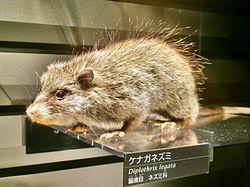Bob
Have a question related to this hub?
Alice
Got something to say related to this hub?
Share it here.
| Ryukyu long-tailed giant rat Temporal range:
| |
|---|---|

| |
| Stuffed specimen. Exhibit in the National Museum of Nature and Science, Tokyo, Japan. | |
| Scientific classification | |
| Kingdom: | Animalia |
| Phylum: | Chordata |
| Class: | Mammalia |
| Order: | Rodentia |
| Family: | Muridae |
| Genus: | Diplothrix |
| Species: | D. legata
|
| Binomial name | |
| Diplothrix legata (Thomas, 1906)
| |
| Synonyms[1][2] | |
| |
The Ryukyu long-tailed giant rat or Ryukyu rat (Diplothrix legata), also known as the rodent in the family Muridae. It is the only extant species in the genus Diplothrix and is endemic to the Ryukyu Islands of Japan. Its natural habitat consists of temperate forests.
The species is threatened by habitat loss, predation by feral cats (with studies finding that the rat contributed 23% of feral cat's diet on Amami-Oshima),[3] and introduced nematode and helminth parasites.[4][5]
{{cite journal}}: CS1 maint: article number as page number (link)